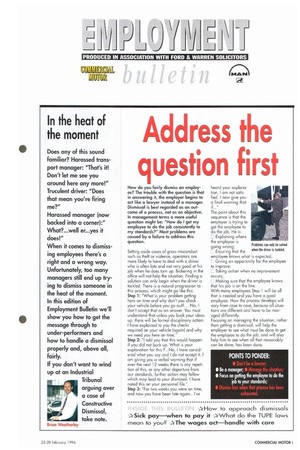Address the uestion first
Page 51

If you've noticed an error in this article please click here to report it so we can fix it.
How do you fairly dismiss an employee? The trouble with the question is that in answering it, the employer begins to act like a lawyer instead of a manager. Dismissal is best regarded as an outcome of a process, not as on objective. In management terms a more useful question might be: "How do I get my employee to do the job consistently to my standards?" Most problems are caused by a failure to address this question.
Setting aside cases of gross misconduct such as theft or violence, operators are more likely to have to deal with a driver who is often late and not very good at his job when he does turn up. Bickering in the office will not help the situation. Finding a solution can only begin when the driver is tackled. There is a natural progression to this process, which might go like this: Step 1: "What is your problem getting here on time and why don't you check your vehicle before you go out No, I don't accept that as an answer. You must understand that unless you buck your ideas up, there will be formal disciplinary action. I have explained to you the checks required on your vehicle (again) arid why we need you here on time."
Step 2: "I told you that this would happen if you did not buck up. What is your explanation For this ?...No, I have considered what you say and I do not accept it. I am giving you a verbal warning that if over the next 12 weeks there is any repetition of this, or any other departure from our standards, further action may follow which may lead to your dismissal. I have noted this on your personnel file.'
Step 3: "For two weeks you were on time, and now you have been late again.. I've heard your explanation. I am not satisfied. I now give you a final warning that if..."
The point about this sequence is that the employer is trying to get the employee to do the job. He is: '1 Explaining where the employee is going wrong; Ensuring that the employee knows what is expected; 7 Giving an opportunity for the employee to improve.
Taking action when no improvement occurs; Making sure that the employee knows that his job is on the line.
With many employees Step 1 will be all that is needed and you have a good employee. How the process develops will vary from case to case, because all situations are different and have to be managed differently.
Focusing on managing the situation, rather than getting a dismissal, will help the employer to see what must be done to get the employee to do the job, and will also help him to see when all that reasonably can be done, has been done.




































































































